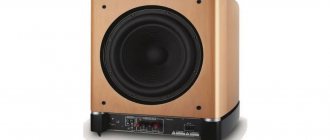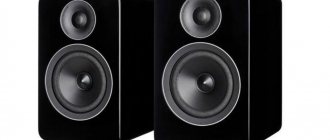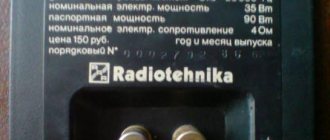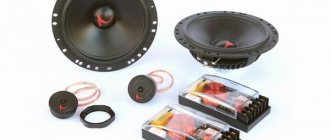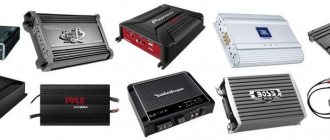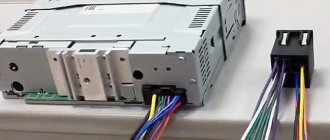- Active speaker systems to ensure high-quality sound at any event
- Active speaker systems are used to provide high-quality sound at any public event, to achieve the most powerful and clean acoustics, as well as to create professional musical accompaniment for concert performances.
- In addition to professional performances, active speaker systems are widely used for music production in clubs and restaurants. In active acoustics, the amplifiers are located inside the speaker housing, making this equipment easy to transport and perfect for use both at outdoor events and in small halls.
- All professional audio equipment, such as Yamaha speaker systems , Proel EXKIT1510 kits, power amplifiers, as well as passive speaker systems and active speaker systems, can be purchased in our online store.
Active speaker system and its choice.
The choice of an acoustic system (AS) is influenced by many factors, among which, first of all, are its specific purpose, the overall dimensions of the room where the audio equipment will be used, its power, the range of reproduced frequencies, the number of bands, and so on. For accessibility, price and excellent sound quality, you can consider using a two-way active speaker system.
Why active and not passive acoustics?
The main difference you need to know about is the presence of a built-in power amplifier in each active speaker speaker. If we highlight the main distinctive properties of active acoustic systems relative to passive speakers, then this is a combination of small overall dimensions and mobility, as well as the absence of the need to broadcast powerful sound over vast distances. The combination of these properties leads to a loss of quality characteristics and an increase in the cost of audio equipment. However, every disadvantage can be turned into an advantage. Namely, to level out the problem areas of active acoustics, manufacturers have taken the path of installing two and three-way modern speakers into speaker cabinets. When installing two-way speakers, we get an excellent option for the combination of price and quality. According to leading experts, the use of 3-way speaker systems allows you to get the highest quality sound, but it is also more expensive. Only those with an ear for music can distinguish two-way acoustics from three-way ones, but for everyone else it will be simply ideal!!!
Five thousand shades of sound
Price - 1,000,000 rubles.
(with SPS-5000 stands) If the concept of High End in audio appeared in the 1990s, then equipment of this class itself existed on the market back in the 1970s. And it was produced by such large companies as Yamaha. Yamaha's legendary NS-1000M monitors with beryllium cones revolutionized sound reproduction, and the new NS-5000 monitors are designed to surpass their success.
To make the diffusers, a copper-nickel alloy coating is applied to a woven Zylon base, giving the domes additional rigidity and the acoustic properties of beryllium. The use of such an innovative material, together with rear cameras of the original RS (Resonance Suppression) form, should effectively prevent the appearance of peaks and dips in the frequency response associated with diaphragm resonance and not “drown” the body.
It's always nice to see how the idols of your youth regain popularity and come to the forefront. It’s as if Ayrton Senna got behind the wheel of a Mclaren-Honda again, Michael Jordan started flying over the ice again as part of the Chicago Bulls, and Vladislav Tretyak appeared in the goal of the Russian national hockey team. I experienced approximately the same feeling when I learned about the release of new monitors by Yamaha - the successors to the NS-1000. In the 1970s and 80s, Yamaha's position in the audio market was very strong, and not just because of its speakers. You can recall the legendary GT series vinyl players, the 10,000th anniversary series amplifiers, and much more. However, times have changed, and since then the production of equipment of this level has suddenly become the province of small garage firms, which are by no means always capable of making technological breakthroughs similar to those made by Japanese companies during the heyday of the Hi-Fi industry. It’s all the more pleasant to see classic-shaped monitors on the shelves again. Although the Yamaha NS-5000 looks strongly reminiscent of its legendary ancestors, the design itself has undergone significant changes. Yamaha's enormous scientific potential has been translated into unique new technologies.
Instead of beryllium, all speakers now use the high-tech material Zylon, which is a woven composite composition used in modern racing cars and astronaut spacesuits. Zilon itself is the strongest synthetic fiber in the world, but to achieve the acoustic properties of beryllium, it was also sprayed with a specially modified Monel alloy using vapor deposition. Moreover, not only the diffusers of the bass drivers are made from it, which would be logical, but also the domes of the mid- and high-frequency speakers. The use of such an innovative material, together with rear cameras of the original RS (Resonance Suppression) form, should effectively prevent the appearance of peaks and dips in the frequency response associated with diaphragm resonance and not “drown” the body. Note that the speakers look very impressive and seem to be woven from silver. The round openwork grilles covering them look no less elegant - the YamahaNS-5000 does not have dustproof nets of the usual format.
The speaker cabinets are made to last, the quality of the finishing with real piano varnish does not raise any questions. At different lighting temperatures, the surface changes its hue, which gives the monitors additional mystery. The speakers came to us for testing with complete SPS-5000 stands, which are ideally suited in design and allow the monitors to be placed exactly at the height of the listener’s seat. True, the scheme for attaching the speakers to the stands did not seem entirely reliable to us - there is only one central bolt, so you need to be careful when moving the speakers along with the stands.
Inside the housing, in addition to traditional sound-absorbing material, asymmetrically located acoustic absorbers are used to combat the occurrence of excess pressure in the internal volume and completely eliminate standing waves.
A bass reflex was chosen as the acoustic design of the YamahaNS-5000 monitors; its port, located in the upper part of the rear wall, has an original twisted profile that prevents the occurrence of turbulent flow in the pipe and, as a consequence, accompanying noise. The crossover is assembled on an element base from the German company Mundorf, a leading supplier of passive components for high-end acoustics and electronics. In general, the quality of components, assembly and applied solutions clearly allow us to say that the acoustics belong to the highest category.
Separately, I would like to touch upon the cost aspect of the YamahaNS-5000. Of course, compared to other models of home acoustics and even electronics from a Japanese corporation, the stated price may seem overpriced, but based on the results of listening and laboratory measurements, it should be said unequivocally that these monitors deserve comparison with equipment from other manufacturers of the same or even higher price category. Unfortunately, in this case we may encounter prejudices resulting from Yamaha's excessively long absence from the market of expensive speaker systems. And many have already forgotten that it was the products of this company that previously served as the standard for beginning High End manufacturers. Today, the company is gradually regaining its lost positions, and let's hope that after the NS-5000, other models of speakers, as well as amplifiers and signal sources of an equally high level, will appear on the market.
In order to fully appreciate the potential of these monitors, you simply need to pair them with a source and amplifier of the appropriate class. Let's say right away that our editorial “integral” Bryston B100 turned out to be not the most suitable partner. Having set ourselves the goal of getting to the bottom of the true capabilities of the speakers, we tried several more devices, including quite exotic ones, and eventually came to the following conclusion. Speakers are capable of amazing sound only in combination with a very powerful amplifier that does not have its own coloration. That is, as neutral as possible, but with good current. While the Yamaha NS-5000s are not measured to be an overly heavy load for the amplifier, they respond gratefully to the extra power. At the same time, the highest resolution and correct timbres speak in favor of the fact that it was tuned by people who have a keen sense of music.
Speakers are capable of amazing sound only in combination with a very powerful amplifier that does not have its own coloration. That is, as neutral as possible, but with good current. While the Yamaha NS-5000s are not measured to be an overly heavy load for the amplifier, they respond gratefully to the extra power.
Once harmony between the acoustics and the amplification part of the system is achieved, it is almost impossible to stop listening. Moreover, it is quite difficult to single out any one feature of the NS-5000 that most captivates the listener. The outstanding level of resolution manifests itself not only in excellent detail, but also, as a result, in the most detailed timbres. The bass is very good, but the degree of its brilliance will be determined by the ability of the amplifier to deliver a large current to the load. Depending on the chosen model, the low-frequency range varies from confident and dense to stunning with a very biting attack; the acoustics’ ability to reproduce the most complex electronic music, saturated with heavy synthesized bass, is especially impressive. We didn't find any of our test tracks that could shake the Yamaha NS-5000's confidence in its abilities.
Measurement results
The graph of the amplitude-frequency response of the Yamaha NS-5000 speaker system looks excellently smooth over a wide range of operating frequencies (Fig. 2). The unevenness in the midrange band does not exceed +\- 0.8 dB. A fairly strong positive imbalance above the second HF octave is observed only when the listener is positioned frontally and strictly on the radiation axis. Proper positioning will eliminate this emphasis. The acoustics have a very large dynamic reserve. Nonlinear distortion occurs to an extremely small extent at measured volume levels. Figure 3 shows the THD for sound pressure levels of 82, 88 and 94 dB. The increase in the coefficient in the bass region does not limit the calculated value of the lower operating frequency of 26 Hz (-10 dB). The behavior of the impedance module is classic for systems with a bass-reflex cabinet design and is very stable in most reproduced frequencies (Fig. 1). The minimum input resistance was 3.9 Ohms.
Advantages of an active two-way speaker system:
- installation of 2 speakers allows you to simplify the design solution in terms of the shape of the speaker housing and the circuit of the isolation filters;
- excellent quality characteristics of speaker matching and ease of adjustment of the frequency section of the playback range;
- simplicity of design.
Selecting an active speaker system
Power is one of the main indicators when choosing a speaker system. However, on average, for high-quality speaker sound, only 10-20% of the maximum is used. For a room with an approximate area of 20-25 m2, a total power of 70-100 W will be sufficient. The given indicator is conditional, because other indicators (corners of the room, furniture, decoration, etc.) that influence the calculation should also be taken into account. The ideal indicator of reproduced frequencies for universal speakers can be considered from 20 Hz to 35 kHz. The best material option for speaker housings is invariably wood!!! In addition, ABS plastic can be used as a budget option. Summarizing all of the above, we can conclude that active two-way acoustics are an excellent choice for medium-sized rooms where good sound is needed and there are no prohibitive requirements for its quality.
